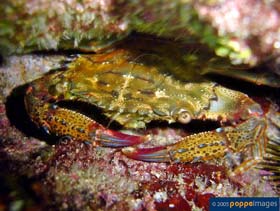Charybdis natator (Herbst, 1794)
Ridged swimming crab| Native range | All suitable habitat | Point map | Year 2050 |

|
| This map was computer-generated and has not yet been reviewed. |
| Charybdis natator AquaMaps Data sources: GBIF OBIS |
Classification / Names Common names | Synonyms | CoL | ITIS | WoRMS
Malacostraca | Decapoda | Portunidae
Environment: milieu / climate zone / depth range / distribution range Ecology
Benthic; depth range 5 - 310 m (Ref. 125642). Tropical
Distribution Countries | FAO areas | Ecosystems | Occurrences | Introductions
Indo-West Pacific: from the Red Sea to China and Australia.
Length at first maturity / Size / Weight / Age
Maturity: Lm ?, range 8 - 9.5 cm Max length : 17.0 cm CW male/unsexed; (Ref. 343)
Short description Morphology
Carapace densely covered with very short pubescence which is absent on several distinct transverse granulated ridges in anterior half. Color: orangish red overall, with ridges on carapace and legs dark and reddish brown.
Maximum depth from Ref. 801. Contributes to fisheries in India and Australia (Ref. 106287).
Life cycle and mating behavior Maturity | Reproduction | Spawning | Eggs | Fecundity | Larvae
Mating behavior: Precopulatory courtship ritual is common (through olfactory and tactile cues); usually indirect sperm transfer (Ref. 833).
Main reference
References | Coordinator | Collaborators
MarineSpecies.org. 2050. (Ref. 3477)
IUCN Red List Status (Ref. 130435: Version 2024-1)
CITES status (Ref. 108899)
Not Evaluated
CMS (Ref. 116361)
Not Evaluated
Threat to humans
Poisonous to eat (Ref. 130554)
Human uses
Fisheries: commercial
| FishSource |
Tools
More information
Trophic Ecology
Ecology
Life cycle
Distribution
Human Related
Aquaculture profile
Stamps, Coins Misc.
Stamps, Coins Misc.
Outreach
References
Internet sources
BHL | BOLD Systems | CISTI | DiscoverLife | FAO(Publication : search) | Fishipedia | GenBank (genome, nucleotide) | GloBI | Gomexsi | Google Books | Google Scholar | Google | PubMed | Tree of Life | Wikipedia (Go, Search) | Zoological Record
Estimates based on models
Preferred temperature
(Ref. 115969): 24.5 - 29.2, mean 28.1 (based on 1314 cells).
Resilience
(Ref. 69278):
High, minimum population doubling time less than 15 months (K=1.1-1.6).
Price category
(Ref. 80766):
Unknown.



